Welcome back to On The Table, my top-of-mind, catching-you-up format. I just realised it’s been three months since I did one of these! So here are my usual sneak peaks into what I have been playing but not writing about in my normal format. Sometimes it’s because I’m still working on the review and need more plays but more frequently because I decided to not officially review a game for one reason or the other.
As always the usual disclaimer: these are not first impressions or reviews, opinions may still change upon further plays.
Sol: Last Days of a Star
Let’s kick things off with Sol: Last Days of a Star. I had been eyeing this one for a while—to be fair mostly because I had heard an anecdote about Cole Wehrle liking it—but it took me a while to find a copy. When recently one came onto the second hand market, I grabbed it … only to later find out I could have just gotten it from the publisher’s website for less money all that time 😂
Despite that, it might be my favourite new acquisition as of late. In Sol, each player has a mothership circling around a sun that’s about to explode. In the lore of the game, civilisations from nearby planets have unknowingly destabilised it by extracting energy from it and now are doubling-down doing so in a race to get enough power for their generational ark ships to escape. Gamewise though it feels more like a positional abstract with fancy minis. Each player has a single mothership that is on auto-pilot around the sun and can send out small spacecraft from where it currently is to activate stations or transform into new ones. While one type of station produces energy, another can turn it into new ships while the third can turn it into VP. Most importantly, gates can be erected to allow players to get into the deeper and more lucrative layers of the sun.
Activating a station means recalling a ship from the station back to the mothership and since one’s mothership continues to circle around the sun, one has to time actions right or a lot of time will just be wasted on moving ships back to the closest gate. Luckily, other players’ infrastructure can also be used, but the owner gets a bonus for doing so. This results in a nice balance between action efficiency considerations, timing, positional plays. To top things off, players get cards for doing certain actions and those provide a game-breaking one-time effect based on a random set of capabilities that’s drawn at the start of the game (e.g. all “blue” cards may allow to move through layers without gates for that turn). The result is a game that has rather few rules, is easy to learn, but keeps feeling fresh each play. The minis look gorgeous, there are some puzzely solo scenarios, optional variants and events. But in other areas the production is a rather strange one. For example, the cards are so plainly looking, I have seen prototypes with better art. Nevertheless, a very fun and entertaining game that has been a hit in my playgroup so far. I will definitely write about it long form soon.

Leaving Earth
Another game I continue to be fascinated with is the 1950s-1970s space race sim Leaving Earth. In it, players get a fixed amount of money each turn to invest in new tech like more powerful rocket stages or the ability to survey planets from orbit. The goal is to complete a randomly drawn set of missions such as being first to have a human in space (and bring them back in one piece) or collect samples from Mars before another player does it. In order to achieve that, one needs to calculate—or rather reverse engineer—the required amount of thrust (=the size and amount of rocket stages) to get stuff to where it needs to be. A simple example: To get a probe onto the moon, one has to spent the weight of the probe times the difficulty to transition it from the moon’s orbit to its surface in rocket stages. But to first get the whole thing from earth’s orbit to the moon’s orbit, one needs even more rocket stages to move the probe PLUS those rocket stages needed later, to get it from the earth’s surface to earth’s orbit even more, and so on. Basically you’re tracing back the path of the mission and keep adding more and more things that can add thrust … but unfortunately also add weight.
I love Leaving Earth’s quirkiness, the strange production with its laser cut wooden pieces, the thematic rulebook, the danger of things going completely down the drain mid-mission. How everything makes me feel like yes, I’m a space agency. The issue is: I can’t seem to get this game played! I tried it solo but unfortunately it has no automa or other faction involved, basically dropping the race character of the game (which is the most interesting aspect for me). As to multiplayer, the prospect of spending a considerable amount of the playtime heads-down doing thrust calculations for then to everything just explode seems to dissuade people from wanting to play it with me. I’ve tried a solo variant a BGG user posted that seemed promising, but unfortunately they have stopped development on it. I might end up having to create one myself.
I’ll definitely keep exploring this one, solo if necessary, it’s that unique a playing experience. And I want the two expansions that exist for it! Unfortunately, I had so far no luck finding them for a decent price. It seems like copies show up on the market only once a year or so and I closely missed two listenings for them. So I guess I’ll have to wait until next year …
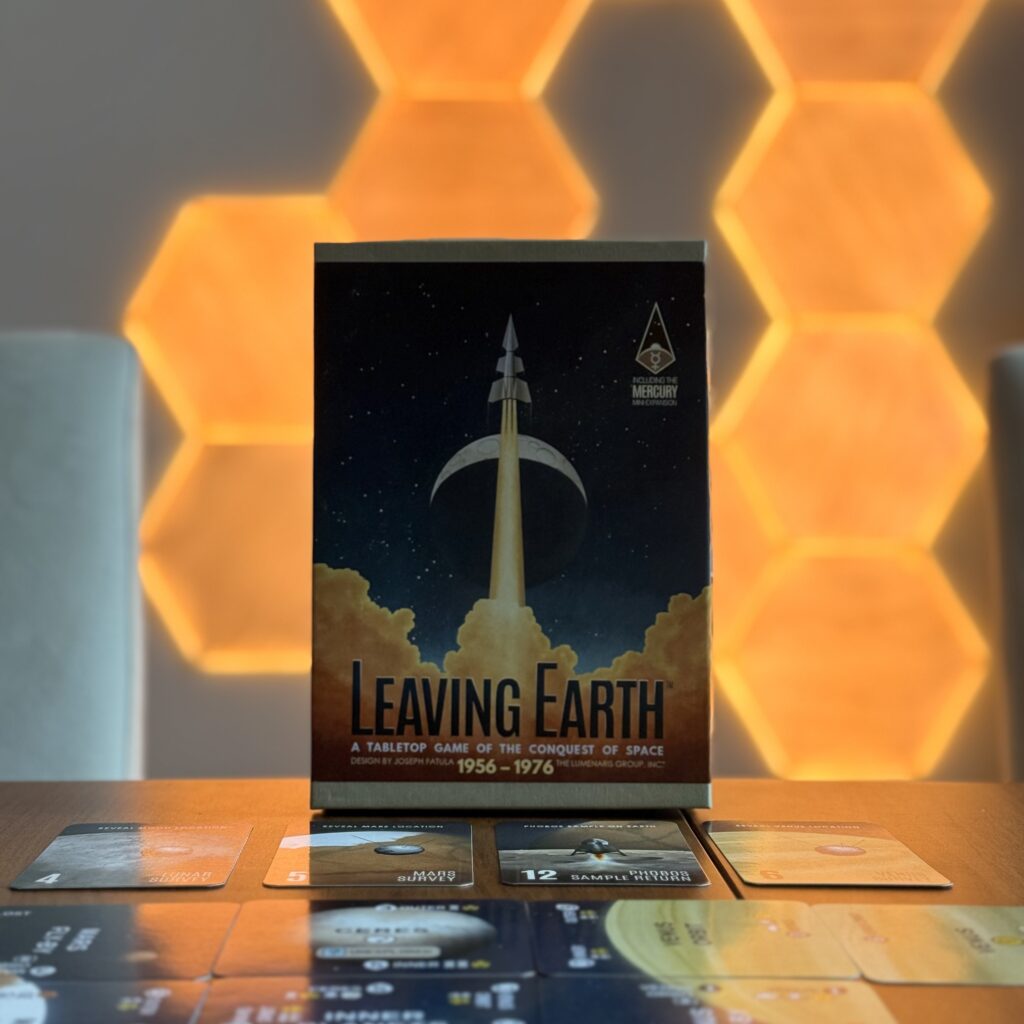
Tycoon: India 1981
This one fulfilled a couple of weeks ago and I have been playing it quite a bit, especially solo. The artwork is vaguely reminiscent of Brass Lancashire/Birmingham, but the gameplay is a rather unusual and unique blend of a multitude of mechanisms. There are two different types of auctions happening each round, a map on which factories can be build, dynamic building costs, industry tracks, special “strategy” actions, buying stocks, one-time use bonus cards, permanent bonus abilities, industry sector leadership, a loan mechanism, tons of instant bonus effects, and and and … but the resulting game isn’t as heavy as you might imagine. There is fierce bidding and the economy is tight, sure, but it’s not like you would build yourself an engine to run or an empire of factories.
Ultimately, there are three victory dimensions: asset value (=how much are your factories and stocks worth), influence (=gained by building factories and various other actions), and favours (=basically doing things the government wants to see). Only the player who is leader in asset value and the one who is leader in influence qualify for winning the game. If these aren’t the same player, the one of them that has collected the most favour tokens wins. This results in an interesting balancing act where you might decide from the get go to completely ignore for example influence and rather make sure you win by most asset value and having more favours than the influence-leader. Or go for both asset value and influence, saving you putting a lot of unnecessary energy into getting favours.
I quite enjoy this one but there is something nagging me about it, I can’t quite put my finger on it yet. Something in the mixture of mechanisms feels slightly off to me, though it’s not any game breaking imbalance, more that I would like certain aspects to have a bigger impact. It’s hard to describe. There is also the issue that stand-in automa have to be used when playing with less than three players which isn’t great in a bidding game (already prompting a friend of mine to say he won’t play it 2p again). And while playing, I get the feeling I’m min-maxing some equation rather than that I would actually build factories or influence politicians. But on the other hand it plays very smoothly, there are lots of clever ideas in here, there is even a small solo campaign included. We brought it out again yesterday and same as before, we had a very close fight until the very end with lots fun to be had. I would also say that Tycoon has been one of the bigger hits recently in my playgroup.
I still need to think about this one before I can voice a proper opinion on it. I already give it this though: it definitely sticks out positively over a flood of forgettable games.
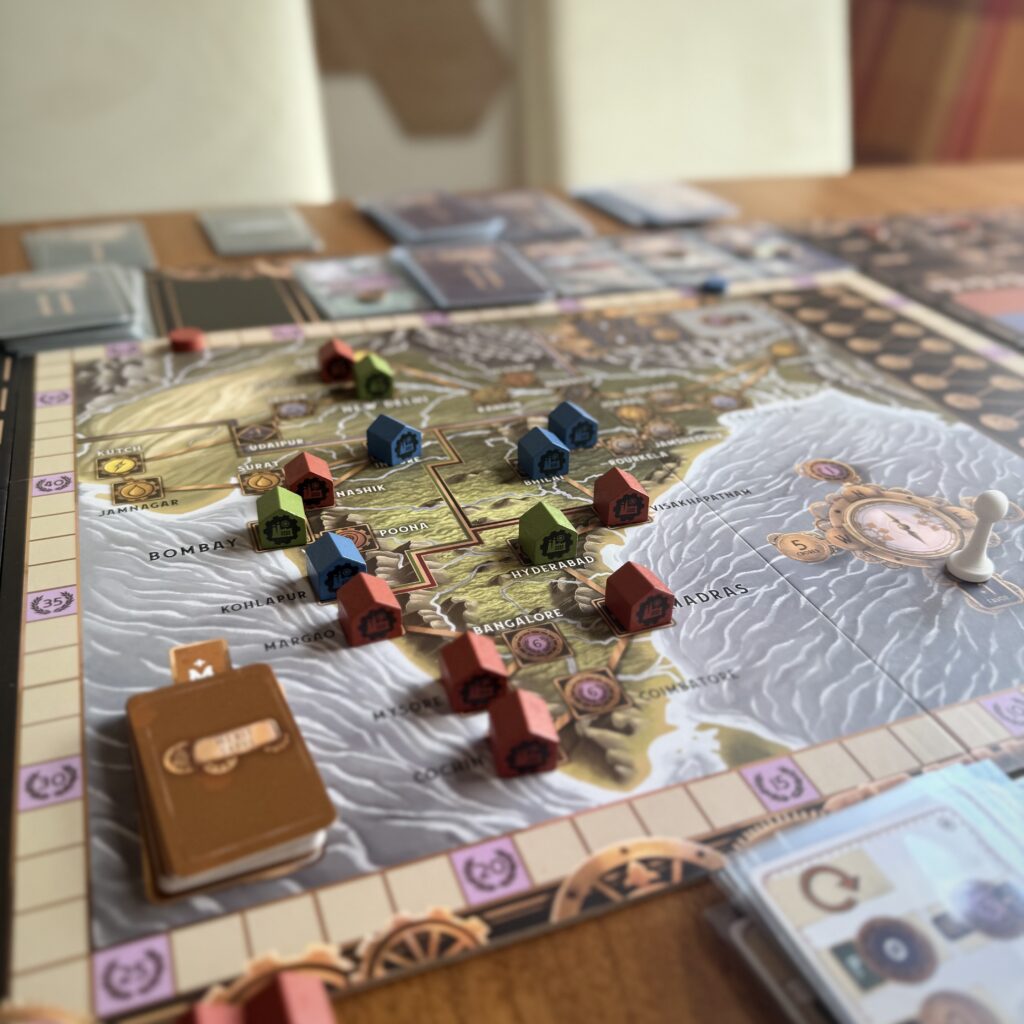
New Cold War
This is my most recent acquisition and I have to admit I just bought it because it looked cool in a picture I saw on Instagram 😀 Plus I’m always war/conflict-game curious, occasionally dipping into GMT territory, though I still have to find one that’s really for me.
In New Cold War, four factions (EU, US, Russia, China) compete in influence around the world. In typical card-driven fashion, players can play cards either for their action points or for the event that’s printed on them, roughly similar to for example a Watergate. In this game though there is the added twist that if a card’s event is intended for another faction, it will get auto-triggered after using it for action points. The deck is also split into three different decades and two factions sort of work together despite being in competition. While there is an additional element of “prestige” and a “media track”, the key interaction is to use action points to claim countries or remove an opposing faction’s influence on them. All of this is mixed with asymmetry in the card deck and which faction has what access to which regions in the world, for example giving the US faction an advantage in the first third of the game that the other players will have to actively act against.
I’m still early into this game. One thing New Cold War definitely does right is that it looks rather fresh and modern for a conflict game. It reminds me of a Pampero or some Ian O’Toole illustrated game, though unfortunately it is completely absent of any flavour text and there are some obvious usability improvements that could have been added. The rules are also way easier to read than the standard GMT fair with lots of examples and tutorial playthroughs.
On the negative side, I’m so far somewhat disappointed by the solo mode and since one has to use the same automa for anything below the full 4p, some people already suggest this to be a game that should only be played 4p. I’ve started developing my own solo variant to have a more natural automa and that already does seem to help a lot. But I’m still curious how much the event cards really induce meaningful decisions or if it’s just a fancy way to give players a random amount of 0-4 action points per move. It definitely feels odd to me that you can draw a so called crisis card (which always have 0 action points) and there is nothing you can do against it, you have to play it and waste one of your moves on it. I’m also wondering how much the asymmetric deck puts each faction on rails when it comes to in which regions in the world one should invest and which one should avoid. We’ll see. As I said, it’s early times and I haven’t even completed a full game yet. But New Cold War has gotten me curious, and that’s already more than a lot of other games achieve.
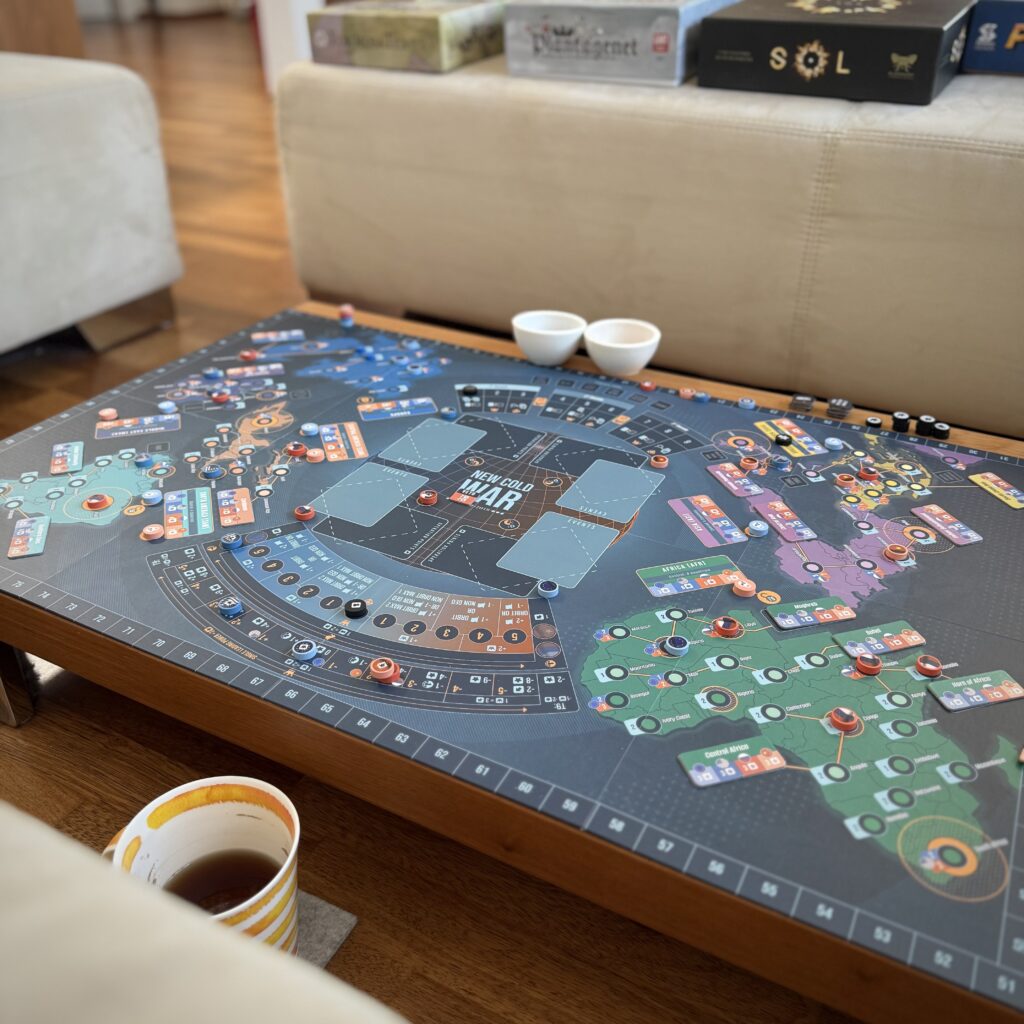
Peacemakers: Horrors of War
I picked this one up after hearing fellow critic Dan Thurot speak about it in his podcast. The premise is quite intriguing: players act as intermediaries between two or more waring factions represented by antropomorphised animals. The factions themselves are steered by two decks of cards forming a combined command for each round like “aggressive strike” or “cowardly movement”. Based on the combination that sometimes can make them act either very powerfully or in complete disarray. The players themselves act co-operatively and play cards to hinder or help the factions in an attempt to wear them down, have them both lose motivation and start peace negotiations.
There are six different scenarios, each with unique command decks and special mechanisms (e.g. one faction doing a siege and firing from a pirate ship while in another someone roles boulders onto the approaching attackers) plus variants for added replay value. The production looks great: nice wooden meeples, colourful illustrations, great insert. I like it as an idea, but somehow I wished the game would be “more”. I could see this work really, really well IF the factions wouldn’t only consists of 3-5 units each and the actions players could do would be a bit more interesting. I for example rarely ever needed to use the “build defences” action at all. I found myself mostly trying to manipulate the command decks and changing cards into producing nonsense commands which wasn’t particularly engaging. Glad I tried it, but it’s already on my to-sell pile. Looks cute as heck though!
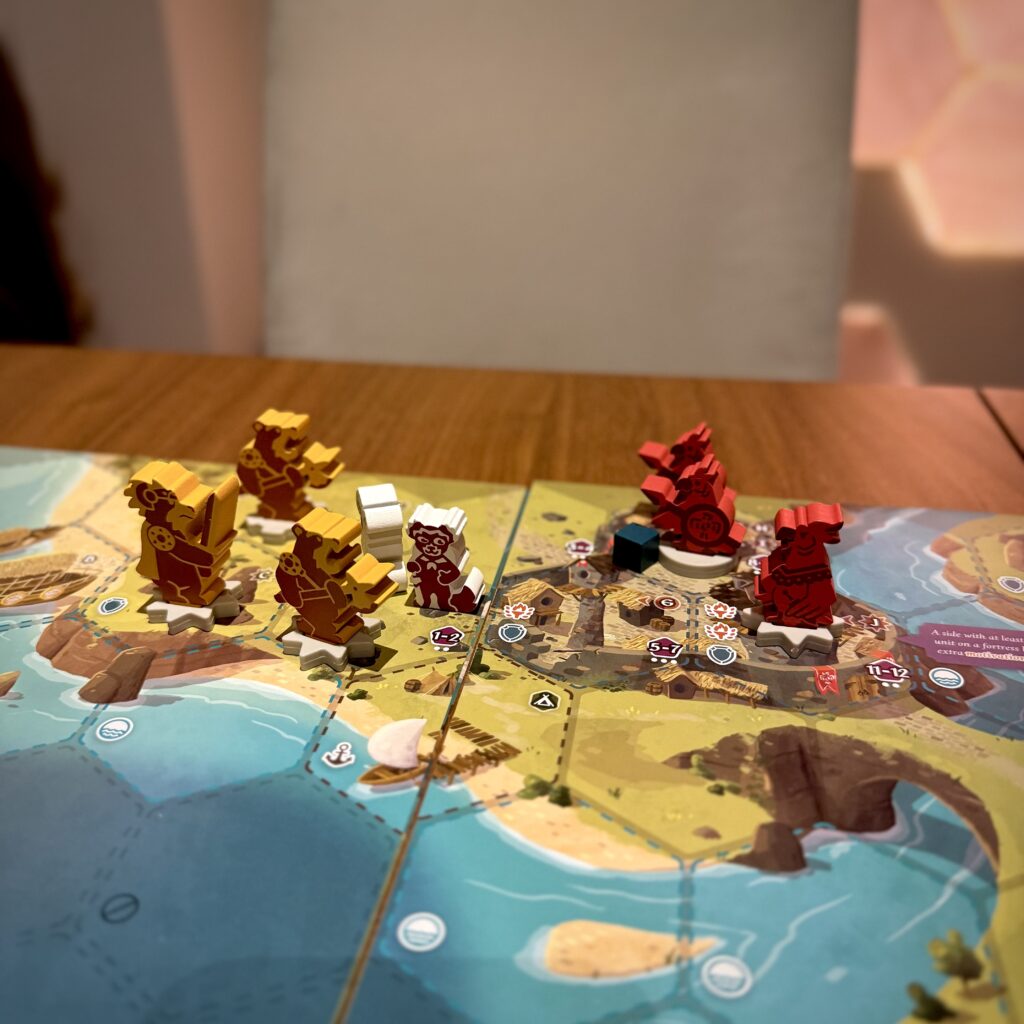
Galactic Cruise
If you know my taste, you might have been wondering why I haven’t already written a review on the hottest Euro of recent times: Galactic Cruise. My copy fulfilled a while ago, but it turned out it just wasn’t my cup of tea. I found I had nothing substantial new to contribute to the discussion, so I didn’t. I know a lot of people really, really enjoy this one, but to put it short, it felt simply too mechanical to me.
In Galactice Cruise, players place their workers to buy new modules for their space ships, pick up tourists and routes, and in general try to make the VP multiplier criteria in their space ships sing as much as possible. Sometimes you will want lots of small ships running often, sometimes large ones carry a lot of guests. You’ll need fuel, food, and air to supply those cruises, advertisement and money, all the euro goodness. There are even one-time use cards that can provide huge benefits if you set up your engine correctly for them. For other players, the same card might be worthless.
In some sense, Galactic Cruise core worker-bumping mechanism is vaguely reminiscent of Vital Lacerda’s The Gallerist, but that’s as far as I would go with the comparison. Both thematically and mechanically, I would more compare it to a very smooth Euro like Tiletum: great if you like triggering small effects here and there to achieve big things, not that remarkable if you want to be emerged in its theme.
Galactic Cruise is definitely a very competent design, but I somehow didn’t find myself engage with it. There unfortunately was nothing in there that made me go “I want to play THIS” instead of reaching for a multitude of other games. And for what it does, the box was just too big (basically two big-box Lacerda stacked on top of each other) and I had too much money tied up in it. So I’ve already passed it on.
Formosa Tea
I like tea a lot, as evident by the number of photos in my reviews that show some giant cup of tea in it. So I was curious about checking out Formosa Tea and picked up a copy of the recently fulfilled 2nd edition when it came up on the second hand market. In typical euro fashion, it’s a worker placement game where players try to collect the right colour of leaves and dry them to produce various categories of tea, ideally in top-notch quality. There are some nice timing considerations that pleasantly surprised us, but overall I had hoped for more: more of the theme to come through, more interesting decisions, more of an urge to return to it.
What doesn’t help is that the designer/publisher still hasn’t released the solo mode that was promised as part of the campaign. I could actually see myself playing this solo a bit. But as is, for me, it’s one of those games that are good but not good enough that I will have to own them myself. It already moved to the to-sell pile unfortunately.
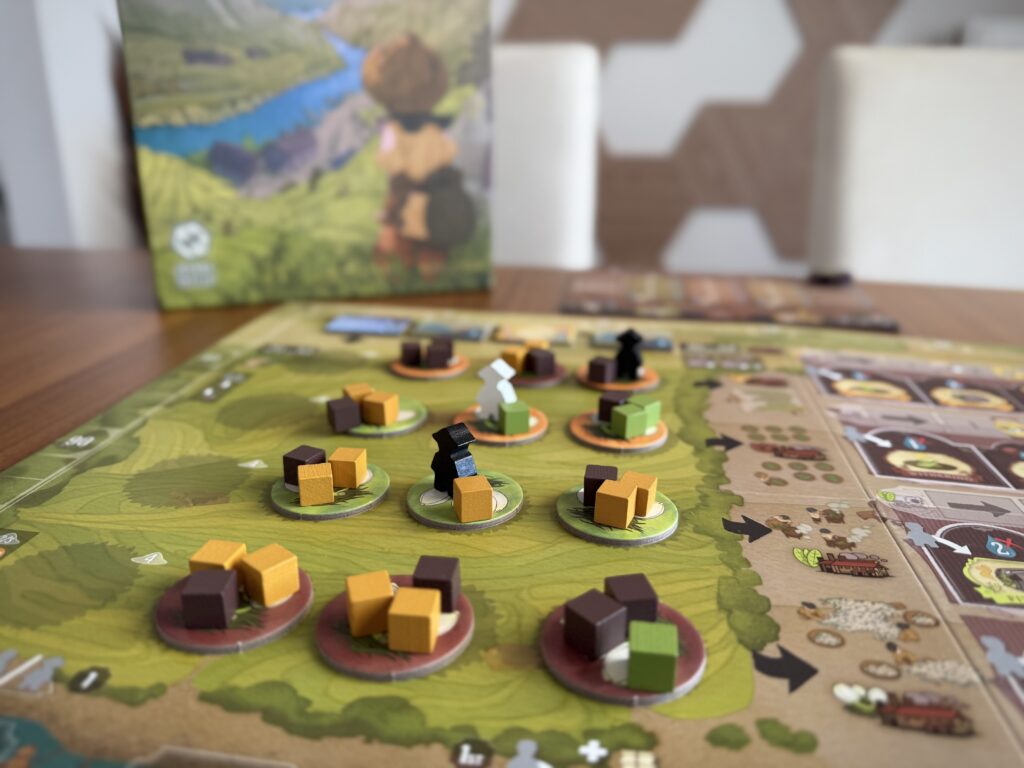
Mercado de Lisboa
After having a good time with House of Fado, I was curious about the other two “smaller” versions of big Lacerda games. Plus I quite liked the big Lisboa and wanted to see how one of its core mechanisms was translated into this game. In Mercado de Lisboa, players are opening up restaurants (=placing tiles) and have to pay money based on the max number of restaurants in its row/column but then earn money for matching customers that are placed around the outside of the market square. More lucrative customers require more restaurants to be in their row/column, so there is an incentive to set up restaurants of the same type in close vicinity and score multiple with one matching guest.
I would have loved to get Bot Factory instead, but Mercado de Lisboa was rather cheap to get second hand … which maybe already wasn’t a good sign. I haven’t played it that much yet, but I think it’s just too light for me. I had hoped it would be more clever and nifty but found it rather bland so far, especially compared to House of Fado. I still want to give it another chance, but it’s pretty much on the to-sell pile already.
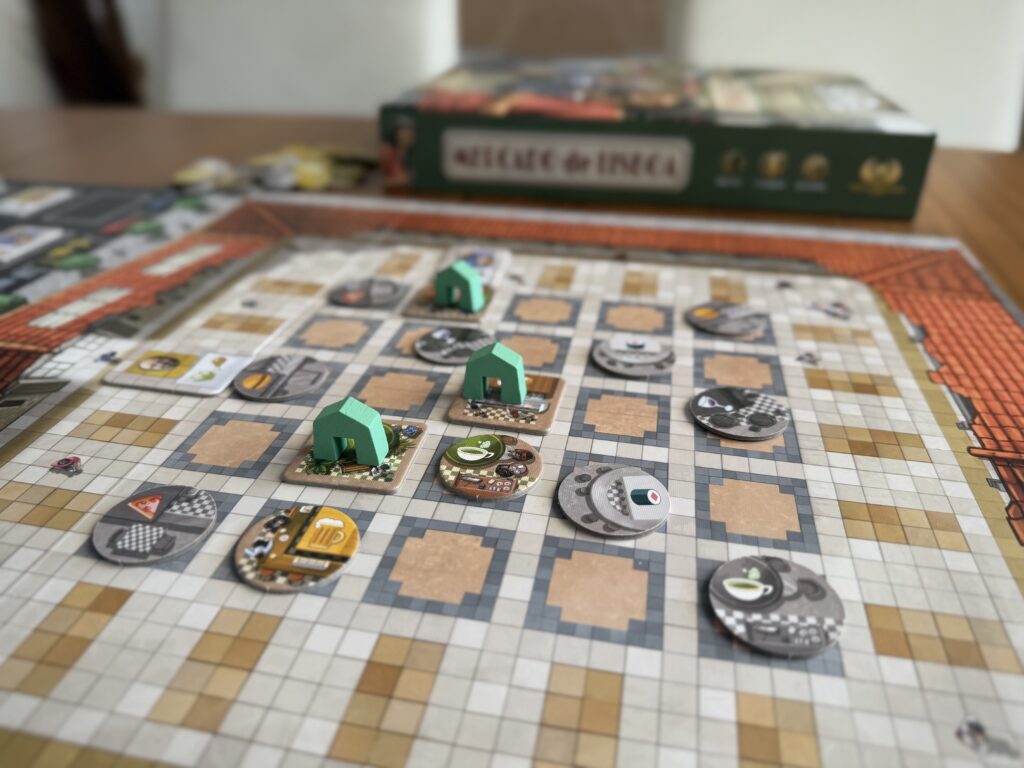
Coffee Rush
Okay, let’s be honest: I just bought this because the components looked so damn cute. Okay, I also wanted to test a submission for the BGG solo design contest, but that was more a side-objective.
In Coffee Rush, you’re moving your worker over the shared tiny main board to collect ingredients and thus fulfill orders that pile up in your café. It’s literally as straight forward as that! Three things spice it a bit: there are abilities to unlock that allow you to get double the ingredients when moving through another meeple or collect stuff from the corner spots. Then there is the fact that all orders move down one row each turn and when dropping off the board become negative points. And finally there is a vs-Tetris like aspect that the players to your left get new orders pushed into their cafe when you complete some. Time things so you complete three order in one turn and delight in hearing your opponents squeal.
It’s a light, super cute game that was fun to play. But we felt there was something a bit off with the balancing and that it had a potential starting player advantage. Happy to play again if someone else asks for it, but I think I don’t need to have it in my collection.

Tranquility The Ascent
Good news: I continue to play Tranquillity the Ascent as an evening cool-down game, so printing my custom playmat hasn’t been just a pet project. In this relaxing co-op game, players climb a mountain by playing numbered cards and thus building the mountain. The main currency of the game is time as represented by the draw deck each player has. If you place a card and there is a pre-existing one next to it, you have to pay the difference in numbers by removing cards from your draw deck. If any player’s deck runs out before reaching the summit, the game is lost. Of course there are a few more rules like not being allowed to place two cards of the same colour next to each other or the number on the car dictating the max-level it can be placed on, but overall it’s a rather simple game.
My main pet peeve with Tranquility The Ascent is that I wish it would be harder. I already play with two of the modules to keep it interesting, but I’m sometimes missing the uncertainty and gambling of the original Tranquility when playing with the variant that removes some of the cards during setup. Will a 53 still come up? Is it even in the deck? Maybe I should keep that 52 …
I’m really looking forward to the third entry in the series: Tranquility the Descent. The pictures I saw already looked drop dead gorgeous.
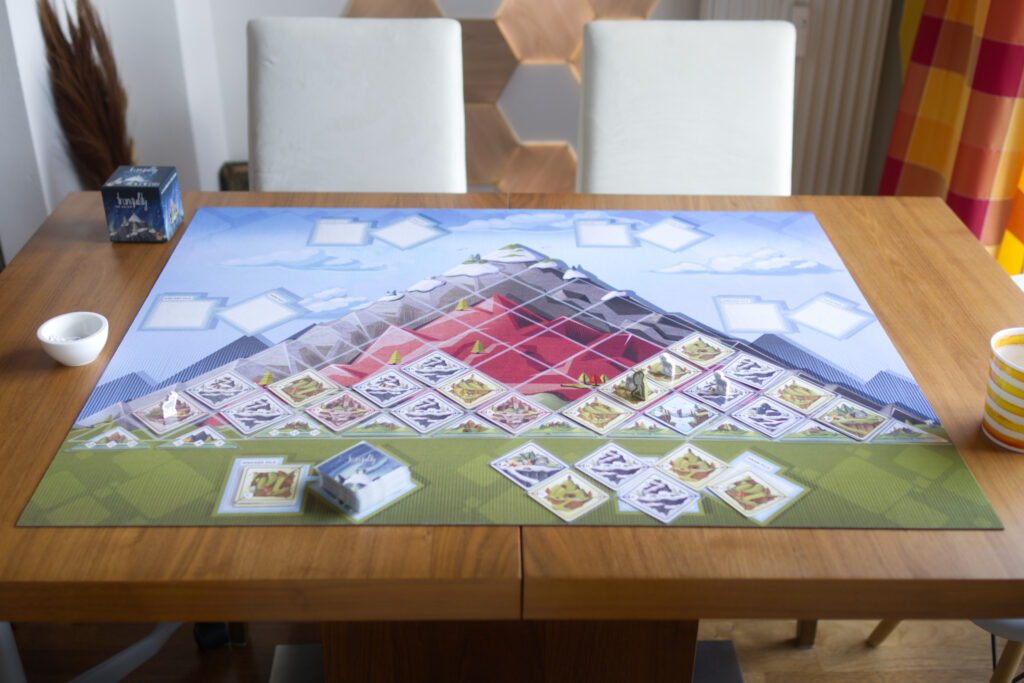
Food Chain Magnate
I had a chance to play another round of FCM again. I owned a copy a while ago but despite my general love for Splotter’s catalogue, this one had left a sour taste for me. Since a friend of mine was interested in revisiting it, I picked up another used copy. And so I can confirm: I still kind of actively hate this game 😂
In Food Chain Magnate, players create their own org chart of employees, from pizza bakers to coaches, to serve customers with various food and drinks. The map itself is assembled from a number of square cardboard pieces, producing a new layout every game. The core idea of FCM is: customers don’t know what they want, so we can tell them with advertisement. Put up a billboard showing burgers close to a house and the inhabitants won’t eat or drink anything if a burger isn’t part of the menu. This of course is a great way to steal away customers from the competition.
It’s the typical Splotter mix of lots of clever mechanisms with a dash of absurdity that makes the whole game a ton of fun. But for me personally, I seem to have a bad time every time I play it. On this occasions, one friend made a slight rules mistakes in where they could place some advertisement and that basically knocked me out of the game on turn two. I spent 3-4h dead in the water, not seeing any way to recover, which granted might be my fault. While I don’t mind this in other Splotter games, I just don’t enjoy seeing the clockwork running in FCM as much and so I was bored and annoyed the whole game, something that very, very rarely happens to me.
Happy end: I simply sold my copy to said friend. He got FCM for cheap and I have finally settled that this is the one Splotter game I won’t play again.
Sagani
Only just yesterday, we brought back Sagani to the table. Gosh, I forgot how much I like this game. It’s not my favourite thing in the world, but it’s just the right mixture of brain burny spatial puzzle while being light enough to not have to take it too serious.
Players draft tiles from a shared market display where each tile shows 1 to 4 coloured arrows pointing in various directions. Each player integrates the tiles they get into their own little playing area. When doing so, they have to place one of their wooden disks per arrow on the tile in the centre of the tile and these are used to cover the arrows when a tile of that colour is added in that direction. Let’s say you pick up a 3 VP tile with a red arrow towards the top-left and a white arrow straight towards the bottom. That means it will lock in 2 disks that you can’t use for other tiles until that tile is completed.
The challenge in this game is: the number of disks each player has is limited. If you pick up a tile that has more arrows than you have disks left, you must pick up additional negative disks which cost you VP. So players are under constant pressure to complete tiles they already have while trying to snatch away those tiles other players need to complete their tiles. E.g. if someone else obviously needs blue tiles and there is just one in the market, it might be a good idea to pick this one up and cause a lot of pain for the other player. And it’s always fun to leave a market only consisting for 4-arrow 10VP tiles for them to choose from.
I’m glad I kept this one. It’s not the most stand out game in the world, but I keep enjoying it whenever I get it out.
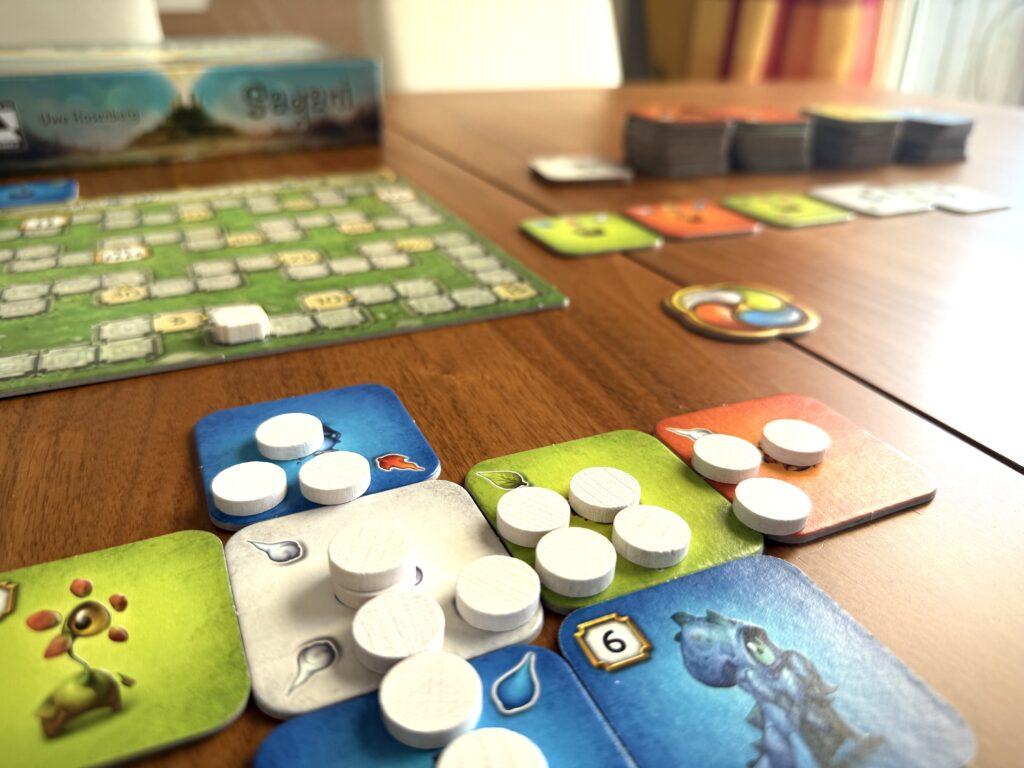
Looking Forward To …
To wrap things up, here are a few games I’m looking forward to:
Sol really has made an impression on me. As a reviewer, I’m often drawn to the next game to explore or the old classic to return to. But this one is so smooth and easy to get out while the special effects cards and events give it a lot of replayability that I enjoy getting it to the table a lot right now. Next week, I’ll be able to play with the full five players for the first time and I’m excited to see how that will feel.
As I said, I have a hard time getting Leaving Earth to the table, but that hasn’t stopped me from starting to design some 3D minis for it. For some reason, I find 3D modelling strangely relaxing. But it’s always a challenge to turn a nicely looking render into something that I can print on my 3D printer. I’ve learned a few tricks by now, so I’m not too worried I’ll be able to make it work here as well.
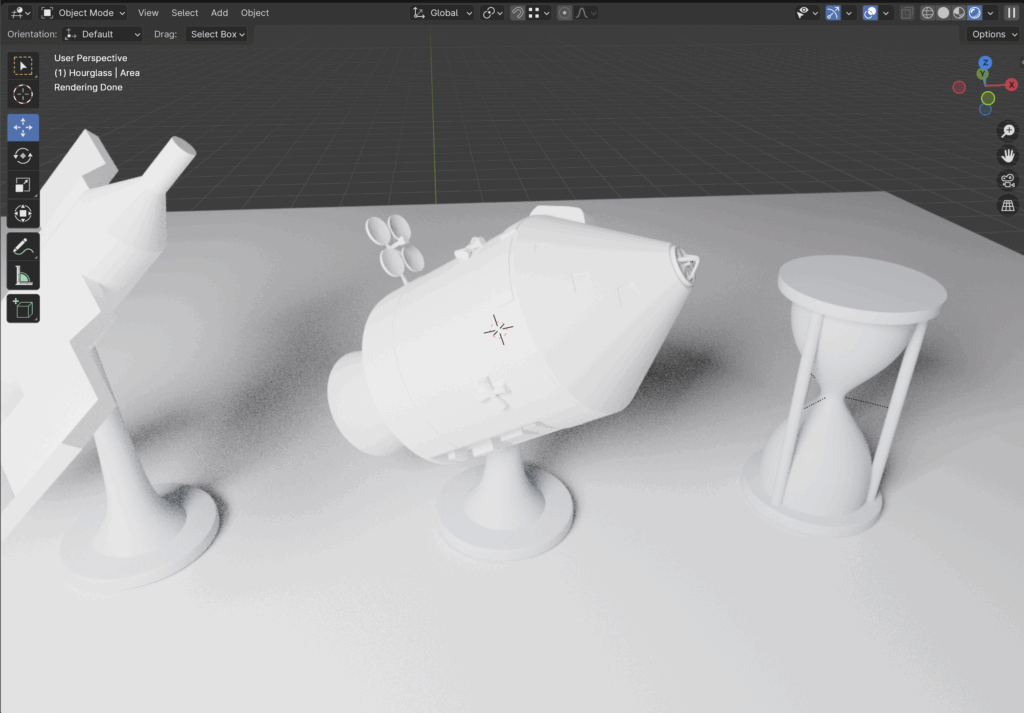
Then there have been first hints that Steam Power might finally fulfil after much delay. If I would have known it would take that long for the deluxe edition to arrive, I’d picked up a retail copy back at SPIEL 24! I’m curious how good the solo mode will be and how much I will enjoy it longterm. That one play at SPIEL I had was quite pleasant but I’m afraid most players will brush this game off as “unremarkable”.
I also finally picked up a copy of Plantagenet by GMT games. A friend of mine really enjoys Nevsky, the first entry in the “levy and campaign” series but somehow I couldn’t find my way into it. As I hinted before, I really don’t like GMT’s style of writing rules! Plantagenet is supposed to be a bit more easy to get in, so I’m looking forward to that one after I’m done with New Cold War.
And in other news, I was excited to read that there will be an expansion for Galileo Galilei called Luna. I don’t get this much to the table despite enjoying the setting and gameplay. So hopefully having more content will help me play it more often again.
What’s been on your table lately? Anything you’re particularly excited about?
